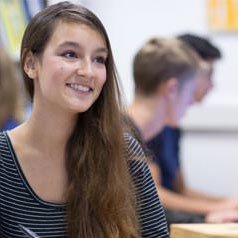Why Choose A Level Fine Art?
A Level Fine Art is an exciting, immersive course designed to push your creative boundaries and develop your artistic voice. Whether you dream of becoming a professional artist, designer, or architect or simply love making art this course provides a dynamic, hands-on experience where you’ll explore new techniques, refine your skills, and build a unique portfolio of work.
Fine Art at A Level is about much more than just drawing and painting. You’ll experiment with a wide range of techniques, from printmaking and mixed media to digital art and sculpture. Throughout the course, you’ll gain a strong understanding of historical and contemporary art movements, learning how artists throughout time have shaped creative practice.
One of the most exciting aspects of A Level Fine Art is the freedom to develop a personal body of work that reflects your own creative journey. Guided by an expert teacher, you’ll explore themes and ideas that truly inspire you, evolving your skills and artistic direction along the way.
You’ll complete two major components that will shape your final grade:
Personal Investigation (60% of your grade) – This is your chance to develop a highly personal project, experimenting with different media and techniques, refining your ideas, and creating final outcomes. Alongside your practical work, you’ll produce an illustrated 1,000-word essay that explores your influences and artistic process.
Externally Set Assignment (40% of your grade) – In your final year, the exam board provides a set of exciting themes for you to choose from. Over three months, you’ll develop ideas and experiment with materials before showcasing your creativity in a final 15-hour practical exam.
Studying Fine Art isn’t just about making work in the studio, you’ll also investigate the work of artists and broaden your critical analysis skills to deepen your understanding of visual culture. This broader context will enrich your own creative approach and help you develop a professional portfolio.
If you love being creative, enjoy hands-on learning, and are eager to develop your own artistic style, A Level Fine Art is for you! Most students have studied GCSE Art (Grade 6 or above), but if you’re coming from a different background, all art departments welcome students with a strong portfolio of work.
A Level Fine Art opens doors to a wide range of creative careers. Many students go on to study Art & Design Foundation courses or specialist degrees in areas like Fine Art, Graphic Design, Fashion, Illustration, Animation, and Architecture. The creative industries are among the fastest-growing sectors worldwide, offering opportunities in everything from film and game design to set production and branding.
While Fine Art is traditionally a two-year course (to allow time for skill development and experimentation), students with significant prior experience may be able to complete it in one year.
If you’re ready to take your creativity to the next level and build a portfolio that showcases your artistic potential, A Level Fine Art is the perfect choice!
Article written by Clare McEwan, teacher of Fine Art, at MPW Cambridge
- A level Art
- A level Biology
- A level Business
- A level Chemistry
- A level Classical Civilisation
- A level Computer science
- A level Drama and Theatre
- A level Economics
- A level English Language
- A level English Language and Literature
- A level English Literature
- A level Film Studies
- A level Geography
- A level History
- A level History of Art
- A level Law
- A level Maths/Further Maths
- A level Media Studies
- A level Modern Languages
- A level Music
- A level Philosophy
- A level Physics
- A level Politics
- A level Psychology
- A level Religious Studies
- A level Sociology
Please feel free to get in touch by
calling 0208 767 8666
emailing us at enquiries@cife.org.uk
or filling in the contact form below.
Our Advice page links to more cife articles.

Interested in studying A level Art?
cife independent sixth form colleges offer:
- Traditional A level Art two year A level courses combining independent schools' small class sizes and emphasis on exam success with the student-centred outlook of the best state state sixth-form colleges
- Intensive, focussed and effective A level Art one year A level courses
- Help starting your revision with Art A level Easter revision courses
- All the benefits of small-group teaching, focus on the individual and a more adult environment to help you achieve better results from Art A level resit courses
Further advice articles
- FAQs about A-level retakes and options for resitting
- Exam remarks - what to do, and when - updated for 2024
- Appealing against your A-level or GCSE results in 2024
- One year A-levels courses at CIFE colleges
- Sixth-form advice articles about university entrance...
- Sixth-form advice articles about study skills...
- Advice articles about sixth-form choices...
Need any help?
Please feel free to contact us for no-obligation, independent advice; either by calling us on 0208 767 8666 or by filling in the form below. We look forward to hearing from you.

